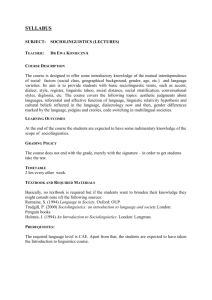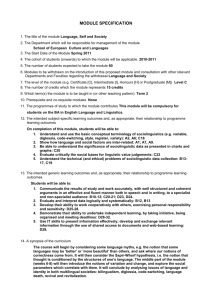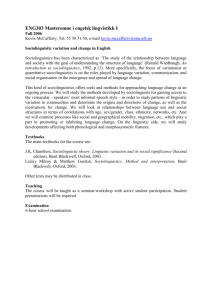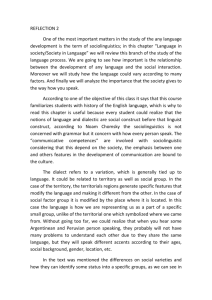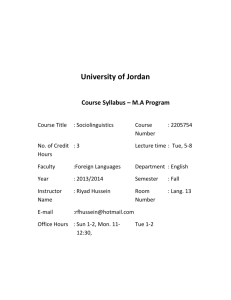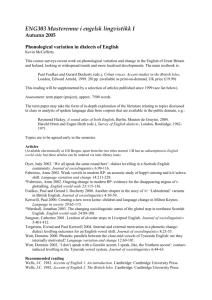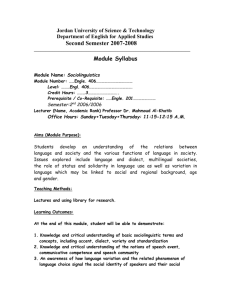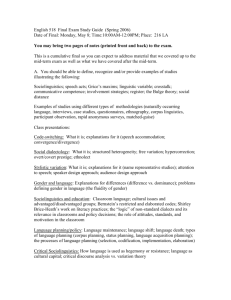SY_1505760_Sociolinguistics_Syllabus
advertisement
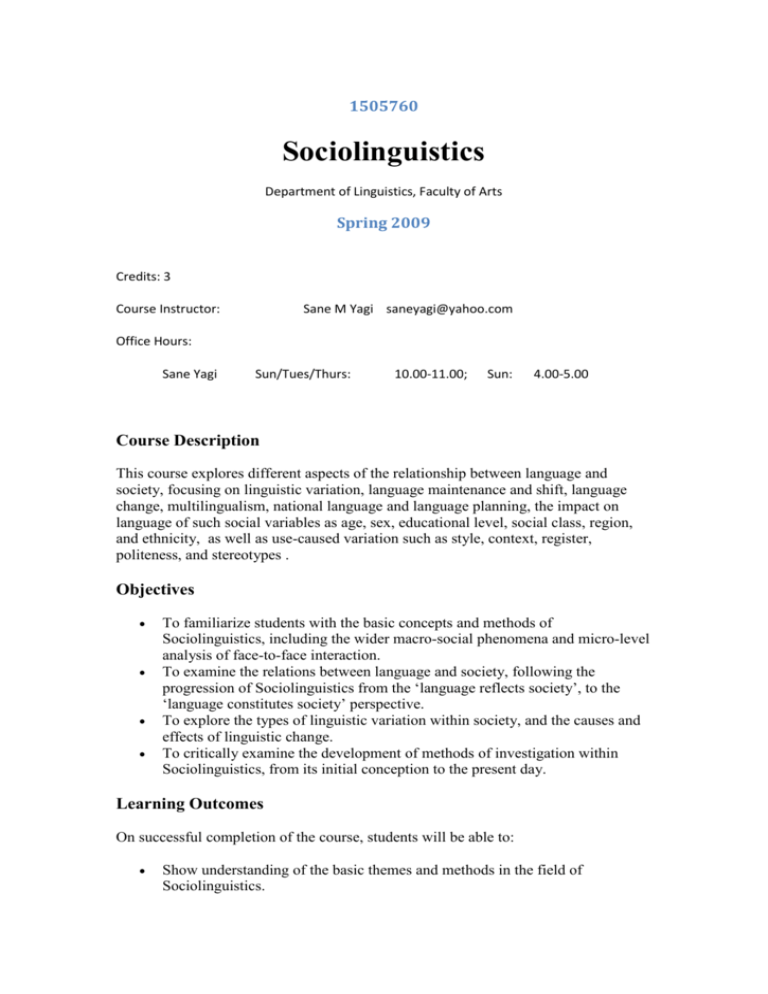
1505760 Sociolinguistics Department of Linguistics, Faculty of Arts Spring 2009 Credits: 3 Course Instructor: Sane M Yagi saneyagi@yahoo.com Office Hours: Sane Yagi Sun/Tues/Thurs: 10.00-11.00; Sun: 4.00-5.00 Course Description This course explores different aspects of the relationship between language and society, focusing on linguistic variation, language maintenance and shift, language change, multilingualism, national language and language planning, the impact on language of such social variables as age, sex, educational level, social class, region, and ethnicity, as well as use-caused variation such as style, context, register, politeness, and stereotypes . Objectives To familiarize students with the basic concepts and methods of Sociolinguistics, including the wider macro-social phenomena and micro-level analysis of face-to-face interaction. To examine the relations between language and society, following the progression of Sociolinguistics from the ‘language reflects society’, to the ‘language constitutes society’ perspective. To explore the types of linguistic variation within society, and the causes and effects of linguistic change. To critically examine the development of methods of investigation within Sociolinguistics, from its initial conception to the present day. Learning Outcomes On successful completion of the course, students will be able to: Show understanding of the basic themes and methods in the field of Sociolinguistics. Identify and analyze variables that can affect language use and language attitudes in a social context. Recognize how language variation can lead to language change. Show understanding of the connections between micro-level language use and wider social structures, demonstrating an awareness of language constituting a form of social action. Critically examine the orthodoxy of earlier studies and methodological tools in Sociolinguistics. Course Schedule Week Topic Resources 1& 2 Introduction to sociolinguistics Janet Holmes’ Sociolinguistics Introduction to 3&4 Language Variation: Dialects; Standard vs American English; Language and Gender; Language and Ethnicity; Language and Politics Burling’s Black English; Nida’s Linguistics and Ethnology in Translation Problems; Smith’s Sex Markers in Speech 5 Language and Age; Language and Social Eckert’s Jocks and Burnouts Class 6 Language Attitudes Whorf’s Language, Mind, and Reality 7 Diglossia Ferguson’s Diglossia; Bergman’s Variation in Colloquial Algerian as a Challenge to Diglossia 8 Code-Switching Bentahila’s The Syntax of ArabicFrenchCode-Switching 9 Language Change Labov’s On the Mechanism of Linguistic Change 10 Language Maintenance Al-Khatib’s Language and Cultural Maintenance Among the Gypsies of Jordan 11 12 & Topics in Applied Swearing; Joking 13 1. Some Major Sociolinguists: Charles 2. Labov’s Thinking about Charles Ferguson; William Labov Ferguson; Interview with William Labov Final Exam 16 Sociolinguistics: Lewis’ The Killing Jokes of the American Eighties; Labov’s Rules for Ritual Insults; Abd el-Jawad’s Swearing in Arabic Assessment Test 30% (on 28/10/2008) Assignments and presentations 10% Term Paper 20% (on 16/12/2008)) Final Exam 40% (on 30/12/2008) Attendance Attendance is essential for successful learning and can affect the achievement of learning outcomes as well as the grade awarded. The University Attendance Policy, which is set out in your student handbook, will be followed. Textbooks Trudgill, P. (2000) Sociolinguistics: An Introduction to Language and Society. London: Penguin. Holmes, J. (2000) An Introduction to Sociolinguistics. London: Longman. Bibliography In addition to the references below, specific readings will be given each week. Some general texts Coulmas. F. (ed.). (2000) The Handbook of Sociolinguistics. Oxford: Blackwell. Coupland, N and Jaworski, J. (eds.) (1997) Sociolinguistics: A Reader and Coursebook. Basingstoke, Hants: Macmillan Fasold, R. (1990) The Sociolinguistics of Language. Oxford: Blackwell Fishman, J. 1998-1999. The new linguistic order. Foreign Policy 16-40. Hudson, R.A. (1998) Sociolinguistics. Cambridge: Cambridge University Press. Pride, J.B. and Holmes, J. (eds.) (1972) Sociolinguistics. Harmondsworth: Penguin. Romaine, S. (1994) Language in Society: An Introduction to Sociolinguistics. Oxford: Oxford University Press. Spolsky, B. (1998) Sociolinguistics. Oxford: Oxford University Press. Trudgill, P. (2000) Sociolinguistics: An Introduction to Language and Society. London: Penguin. Wardhaugh, R. (2002) An introduction to Sociolinguistics. Oxford: Blackwell. More specific readings Adams, H. D. and O. Elliot. Jr. 1997. Sources of variation in interlanguage. IRAL 35:87-98. Bader, Y. and D. Mennis. 1998. A sociolinguistic analysis of brand names in Jordan. Abhath Al-yarmouk (Lit & Ling) 16:31-47. Brown, P. and Levinson, S.C. (1987) Politeness: some universals in language use. Cambridge: Cambridge University Press. Calvet, J-L (1998). Language Wars and Linguistic Politics. Oxford: Oxford University Press. Cameron, D. (2001) Working with Spoken Discourse. London: Sage. Chambers, J.K and Trudgill, P (1998) Dialectology. Cambridge: Cambridge University Press Cheshire, J. and Trudgill, P. (eds.) (1998) The Sociolinguistics Reader Volume 2: Gender and Discourse. Oxford: Oxford University Press Coates, J. (1998). Language and Gender: A Reader Oxford: Blackwell. Coates, J. and Cameron, D. (eds.) (1990) Women in their Speech Communities: New Perspectives on Language and Sex. New York: Longman. Croft, W. (2000) Explaining Language Change. London: Longman. Crystal, D. (2000. Language Death. Cambridge: Cambridge University Press. Eckert, P. (2000) Linguistic Variation as Social Practice. Oxford: Blackwell. Edwards, J. (1994). Multilingualism. Harmondsworth: Penguin. Fishman, J. A. (2001) Reversing Language Shift. Philadelphia: Multilingual Matters. Fishman, J. A. (ed.) (2000) Can threatened languages be saved? Toronto: Multilingual Matters. Heller, M. (ed.) (1988) Code-Switching: Anthropological and Sociolinguistic perspectives. Berlin: Mouton de Gruyter. Jaworski, A. and Coupland, N. (eds.) (1999) The Discourse Reader. London: Routledge. Labov, W. (1972) Sociolinguistic Patterns. Oxford: Blackwell. Li Wei (ed.) (2000). The Bilingualism Reader: London: Routledge. McMahon, A.M.S. (1999) Understanding Language Change. Cambridge: Cambridge University Press. Milroy, L. (1980) Language and Social Networks. Oxford: Blackwell. Milroy, L. and Gordon, M. (2003) Sociolinguistics: Method and Interpretation. Oxford: Blackwell. Milroy, L. Muysken, P. (1995) One Speaker Two Languages. Cambridge: Cambridge University Press. Muysken, P. (2000) Bilingual Speech. Cambridge: Cambridge University Press Romaine, S. (1982) Sociolinguistic Variation in Speech Communities. London: Arnold. Romaine, S. (1995) Bilingualism. Oxford: Blackwell. Sebba, M. (1997) Contact Languages. Basingstoke: Macmillan. Thomason, S.G. (2001) Language Contact: an Introduction. Edinburgh: Edinburgh University Press. Trudgill, P. and Cheshire, J. (1998) The Sociolinguistics Reader Volume 1: Multilingualism and Variation. London: Arnold. Wardaugh, R. (1987) Languages in competition. Oxford: Blackwell. Winford, D. (2003) An Introduction to Contact Linguistics. Oxford: Blackwell. Journals Discourse and Society Journal of Sociolinguistics Language and Communication Language in Society Language Variation and Change. Multilingua International Journal of Multilingualism International Journal of the Sociology of Language Journal of Language and Social Psychology Journal of Multilingual and Multicultural Development

